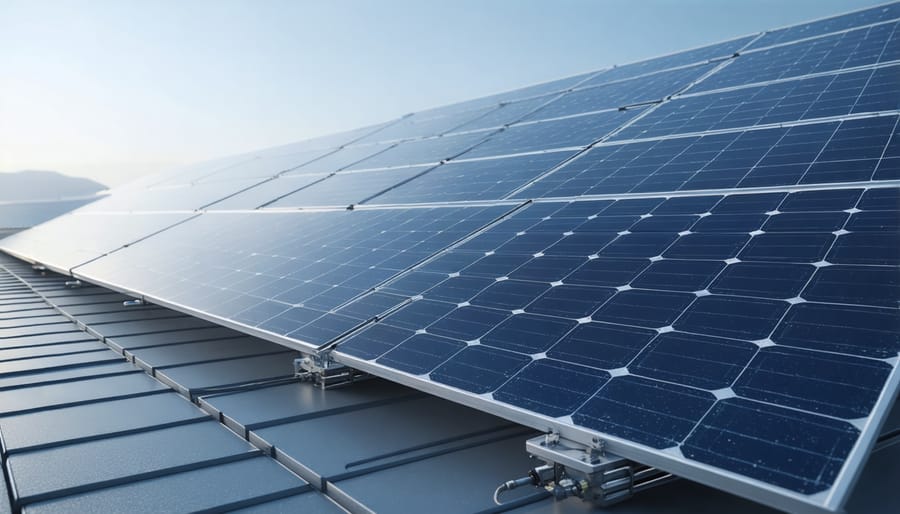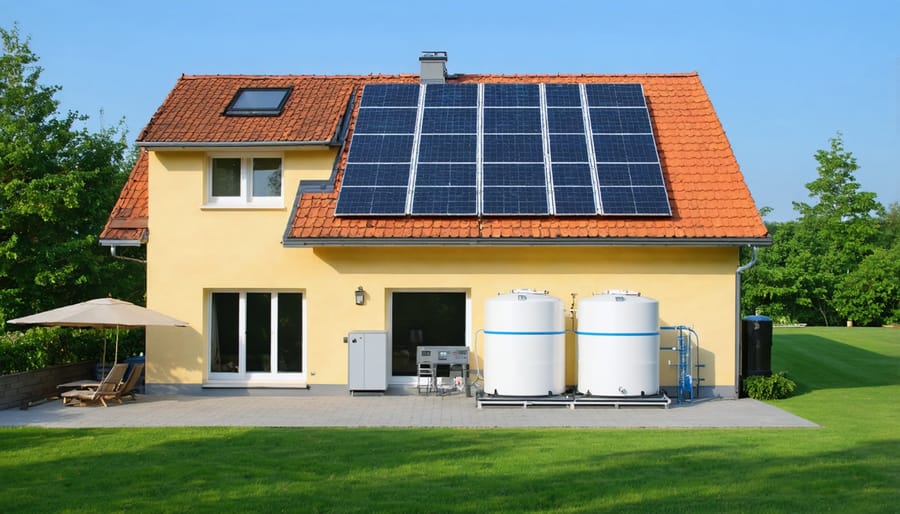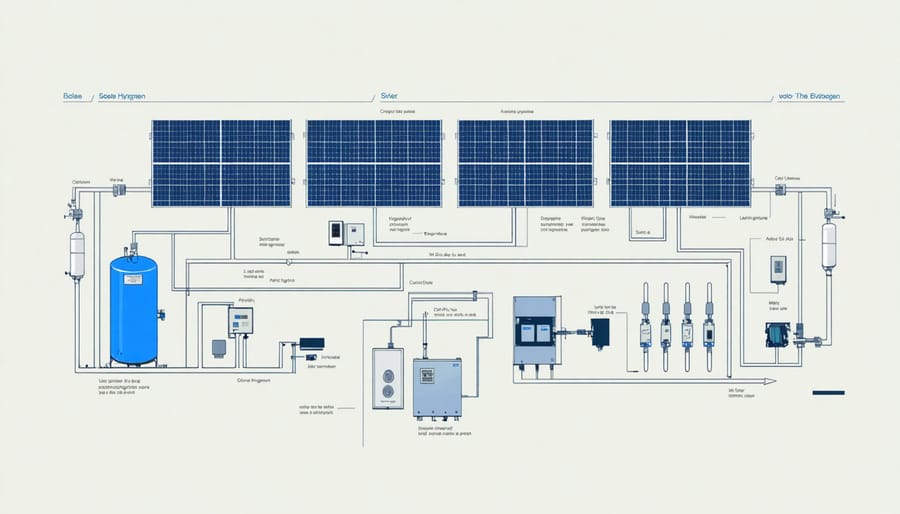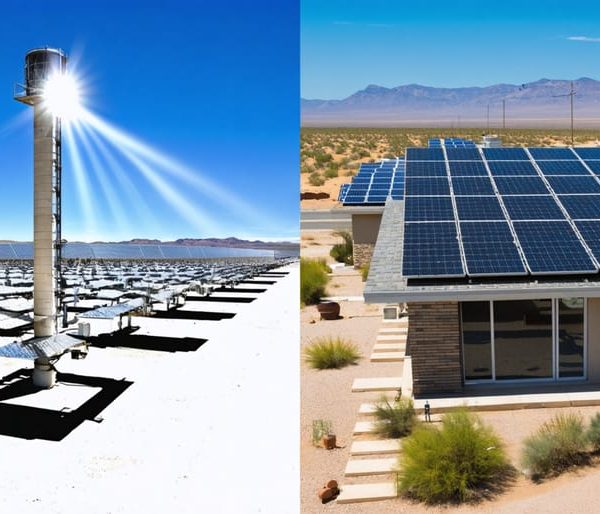Solar-to-Hydrogen Breakthrough Makes Clean Energy Storage a Reality
Solar technology has undergone a remarkable transformation in the past decade, making clean energy more accessible and affordable than ever before. Recent breakthroughs in solar panel efficiency, particularly with perovskite cells achieving conversion rates above 29%, have revolutionized how we harness the sun’s power. These advancements, combined with dramatic cost reductions of over 70% since 2010, are putting sustainable energy within reach for average homeowners.
Today’s solar innovations extend far beyond traditional rooftop panels. Smart solar tiles that blend seamlessly with your home’s architecture, advanced energy storage systems that provide reliable backup power, and AI-powered optimization technology are transforming how we think about residential solar solutions. These developments aren’t just technical achievements – they’re practical tools that help homeowners slash energy bills while contributing to a cleaner planet.
As we witness this solar revolution, one thing becomes clear: the future of home energy is bright, efficient, and increasingly affordable. Whether you’re considering your first solar installation or upgrading existing systems, there’s never been a better time to embrace solar power.
The Latest Solar-to-Hydrogen Technology

Advanced Photovoltaic Materials
The world of advanced photovoltaic materials has seen remarkable breakthroughs in recent years, pushing solar panel efficiency to new heights. Leading this revolution are perovskite solar cells, which have achieved conversion rates above 29% in laboratory settings – a significant improvement over traditional silicon panels. These materials are lighter, more flexible, and can be manufactured at lower temperatures, making them both cost-effective and environmentally friendly.
Another exciting development is the emergence of multi-junction cells, which combine different materials to capture a broader spectrum of sunlight. By layering various semiconductors, these panels can convert more sunlight into usable electricity, with some designs reaching efficiency rates of up to 47% under concentrated sunlight.
Transparent solar materials are also gaining traction, opening up possibilities for windows that generate power while maintaining visibility. These innovations aren’t just laboratory curiosities – they’re making their way into commercial products, promising to transform everything from skylight installations to car sunroofs into energy-generating surfaces.
Enhanced Electrolysis Systems
Recent breakthroughs in water-splitting technology have revolutionized how we convert solar energy into clean hydrogen fuel. These enhanced electrolysis systems now achieve impressive efficiency rates of up to 25%, making them increasingly practical for both home and commercial use.
The latest systems use advanced catalysts made from earth-abundant materials like nickel and iron, replacing expensive platinum-based components. This innovation has cut production costs by nearly 60% in the past five years. The new catalysts also last longer, requiring less maintenance and providing more consistent performance.
What’s particularly exciting is the development of compact units specifically designed for residential use. These systems can integrate seamlessly with existing solar panel setups, storing excess daytime energy as hydrogen for later use. The stored hydrogen can power fuel cells during nighttime or cloudy days, offering a reliable backup power solution.
The process is remarkably straightforward: solar-generated electricity powers the electrolysis unit, which splits water into hydrogen and oxygen. The hydrogen is safely stored in specially designed tanks, ready to be converted back into electricity when needed. This closed-loop system represents a significant step toward energy independence for homeowners.
Practical Applications for Homeowners
Home Energy Storage Solutions
Solar-to-hydrogen systems are revolutionizing home energy storage, offering an innovative alternative to traditional integrated battery storage solutions. These systems capture excess solar energy and convert it into hydrogen, which can be stored indefinitely and used when needed.
The process is remarkably straightforward: excess electricity from your solar panels powers an electrolyzer, which splits water into hydrogen and oxygen. The hydrogen is safely stored in tanks, ready to be converted back into electricity through a fuel cell whenever you need power – day or night, rain or shine.
What makes this technology particularly exciting for homeowners is its long-term storage capability. Unlike traditional batteries that gradually lose charge over time, hydrogen can be stored for months without any energy loss. This makes it perfect for seasonal energy storage, allowing you to save summer’s abundant solar energy for winter use.
The system’s scalability is another major advantage. Whether you’re powering a modest home or a larger property, hydrogen storage systems can be sized to meet your specific needs. While the initial setup costs are currently higher than traditional battery solutions, the longer lifespan and minimal maintenance requirements make it an increasingly attractive option for sustainable home energy storage.
Many homeowners report significant reductions in their carbon footprint and complete energy independence after installing these systems, making them a promising solution for the future of residential renewable energy.

Cost-Benefit Analysis
Modern solar technology offers an impressive return on investment that makes it increasingly attractive for homeowners and businesses alike. Recent studies show that the average solar installation pays for itself within 5-7 years, with some systems achieving payback even faster through cost savings with hybrid systems.
The initial investment for a residential solar system typically ranges from $15,000 to $25,000, but federal tax incentives can reduce this cost by up to 30%. Many states offer additional rebates and incentives, potentially lowering the upfront costs by another 10-20%. Monthly energy savings average between $100 and $200, depending on location and system size.
Long-term benefits are even more compelling. Today’s solar panels come with 25-year warranties and can last up to 30 years, providing decades of reliable energy production. Property values typically increase by 4-6% with solar installation, offering an immediate return on investment through increased home equity.
Maintenance costs remain minimal, usually requiring only annual cleaning and occasional system checks. With energy prices continuing to rise, solar technology provides a hedge against future utility rate increases while delivering predictable energy costs for decades to come.
Installation and Maintenance

System Components
Modern solar systems comprise several key components working together seamlessly to harness the sun’s energy. At the heart of every installation are the photovoltaic (PV) panels, which convert sunlight into electricity. These panels have become increasingly efficient, with many now featuring bifacial technology that captures light from both sides.
The inverter serves as the system’s brain, converting DC power from your panels into usable AC electricity for your home. Smart inverters now offer real-time monitoring and optimization capabilities through user-friendly mobile apps.
Energy storage solutions, typically in the form of lithium-ion batteries, store excess power for use during nighttime or cloudy days. These batteries have become more compact and affordable, making them an attractive option for homeowners.
A mounting system securely attaches panels to your roof or ground installation, while sophisticated tracking systems can adjust panel angles throughout the day to maximize energy capture.
The monitoring system keeps track of your energy production and consumption, helping you optimize usage patterns. Modern systems include safety equipment like rapid shutdown devices and surge protectors, ensuring your installation meets current safety standards.
Lastly, a bi-directional meter connects your system to the power grid, enabling net metering and power exchange with your utility company.
Maintenance Tips
To keep your solar system operating at peak efficiency, regular maintenance is essential but surprisingly simple. Most modern solar panels are designed for minimal upkeep, but a few routine checks can significantly extend their lifespan and performance.
Clean your panels every three to six months using plain water and a soft brush or sponge. Avoid cleaning during peak sunlight hours or when panels are hot. In dusty areas or during pollen season, you might need more frequent cleaning. Remember to clear away leaves, branches, and debris that could cast shadows on your panels.
Monitor your system’s performance through its accompanying app or monitoring system. A sudden drop in energy production could indicate an issue requiring professional attention. Check the inverter display regularly – a green light typically means everything’s working correctly.
Inspect mounting hardware and wiring connections annually for signs of wear or loose components. After severe weather, do a quick visual check for any damage. If you notice cracks, discoloration, or loose parts, contact your installer immediately.
Consider scheduling professional maintenance every two years for a thorough inspection and cleaning. This preventive approach helps catch potential issues before they become major problems and ensures your warranty remains valid.
Future Developments
The future of solar technology is brimming with exciting possibilities that could revolutionize how we harness the sun’s energy. Scientists are currently developing perovskite solar cells, which promise to be more efficient and significantly cheaper to produce than traditional silicon panels. These next-generation cells could boost energy conversion rates above 30%, making solar power even more attractive for homeowners.
Another groundbreaking development is the creation of transparent solar panels, which could transform windows into power generators. Imagine your home’s windows quietly producing electricity while maintaining their primary function! This technology could be particularly game-changing for urban environments and high-rise buildings.
Solar storage solutions are also evolving rapidly. New battery technologies using sustainable materials are being developed, promising longer life spans and improved energy retention. These advancements could make it possible for homes to be truly energy independent, storing excess power for weeks rather than just days.
Scientists are also working on solar paint, which could turn any surface into a power generator. This innovative coating could allow homes to generate electricity through their walls and roofs without traditional panels. Additionally, bifacial solar panels, which can capture sunlight from both sides, are becoming more efficient and could soon become the new standard for residential installations.
These developments aren’t just improving efficiency – they’re also focusing on sustainability. Researchers are designing solar panels that are fully recyclable, addressing current end-of-life concerns and making solar energy even more environmentally friendly.
The future of solar technology has never looked brighter. From more efficient photovoltaic cells to innovative storage solutions, these advancements are making solar energy more accessible and practical than ever before. By embracing these technologies, homeowners and businesses can significantly reduce their carbon footprint while enjoying substantial energy savings. The decreasing costs, improved efficiency, and enhanced durability of modern solar systems make now the perfect time to invest in solar power. Whether you’re considering rooftop panels or exploring community solar projects, the benefits of adopting solar technology extend far beyond individual savings – you’re contributing to a cleaner, more sustainable future for generations to come. Take the first step today and join the growing community of solar adopters who are leading the charge toward a renewable energy future.






